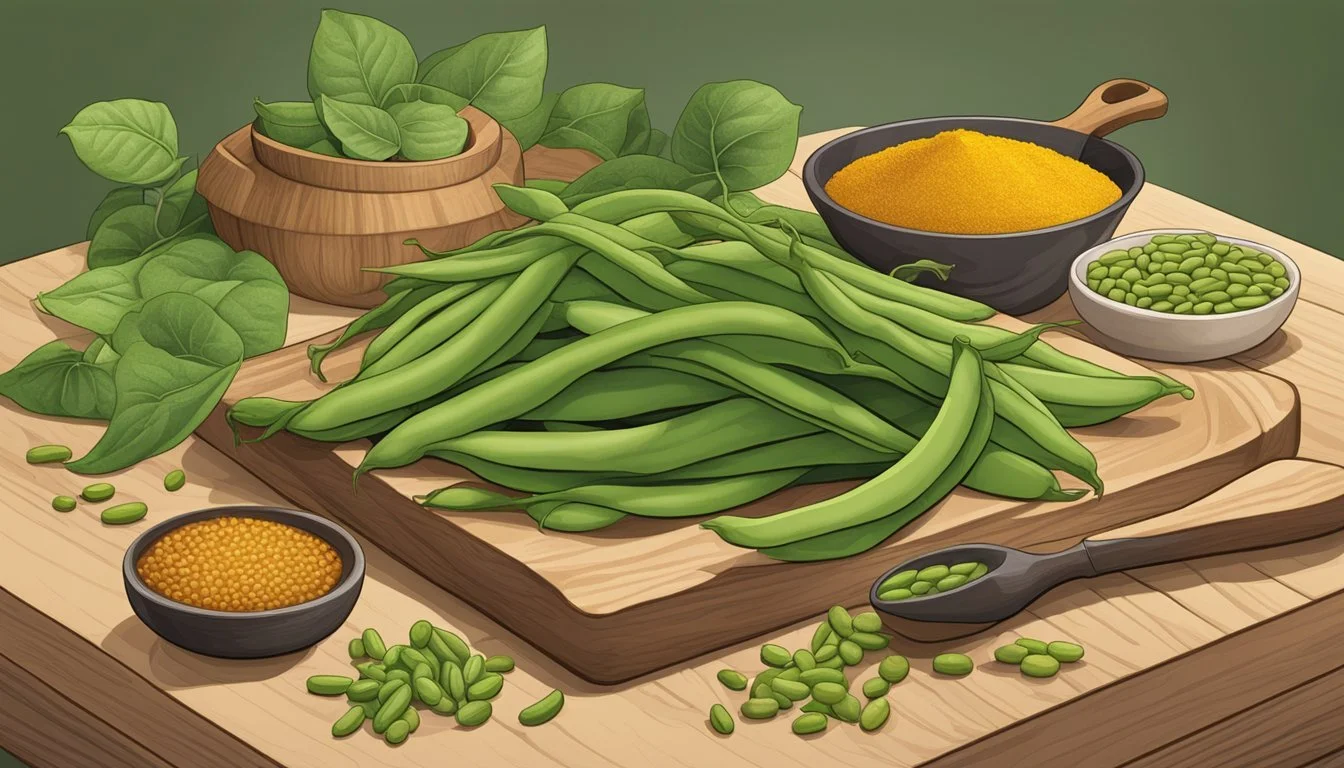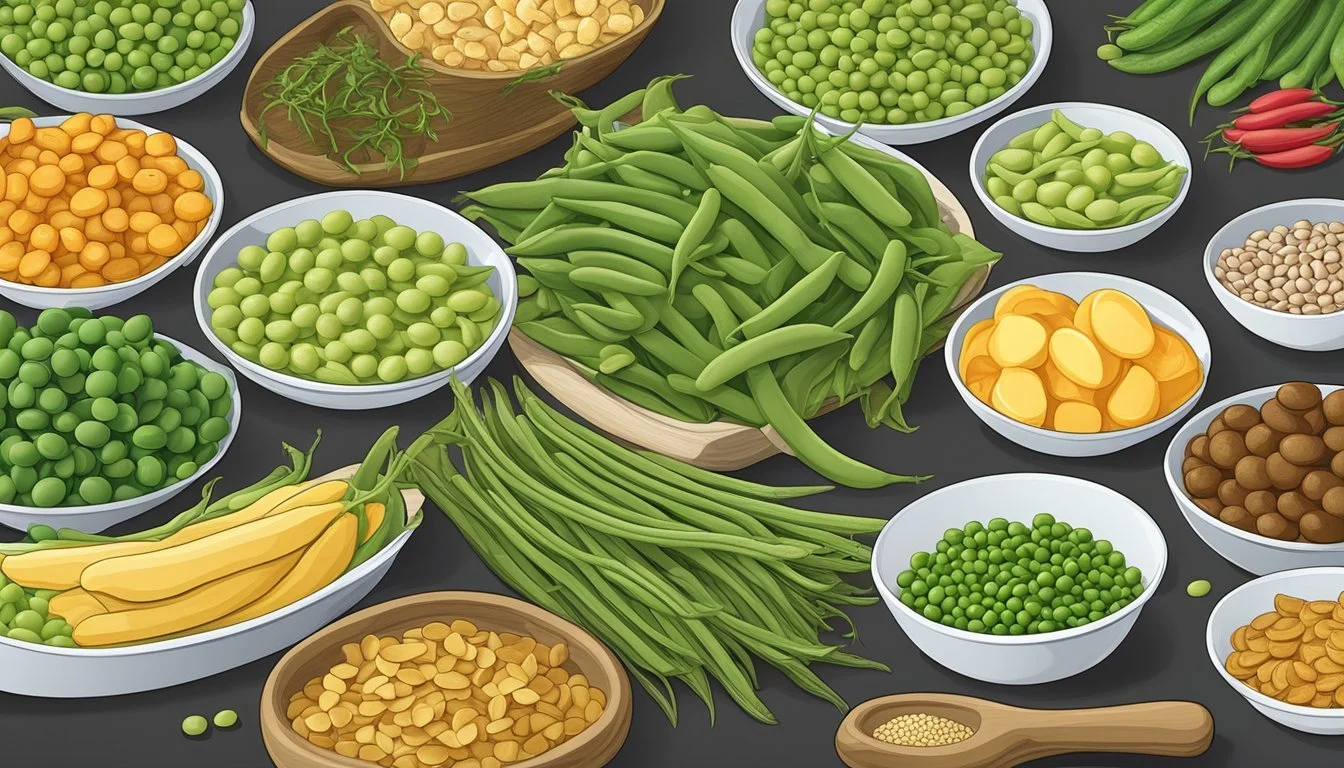Runner Beans Substitutes
Best Alternatives for Your Recipes
Finding a suitable substitute for runner beans can enhance your cooking repertoire and ensure your dishes remain delicious and nutritious. Green peas offer a similar flavor and are a versatile substitute for runner beans in various recipes, especially soups. Additionally, snap peas or snow peas bring a crisp texture and can be a fresh alternative in your salads or stir-fries.
Another excellent replacement is zucchini. When cooked, zucchini has a texture that closely mimics runner beans, making it a flexible option for casseroles and stir-fries. Zucchini can be substituted at a 1:1 ratio, sliced, and sautéed for about five minutes to achieve the desired consistency.
Exploring different beans, such as butter beans or green beans, also broadens your culinary horizons. Incorporating these substitutes allows you to maintain the protein and fiber content in your meals, ensuring they are both healthy and satisfying.
Understanding Runner Beans
Runner beans, scientifically known as Phaseolus coccineus, are a type of legume known for their long, flat pods and vibrant flowers. They are recognized for their distinctive texture and nutritional benefits, making them a popular choice in a variety of dishes.
Characteristics and Nutritional Profile
Runner beans are known for their large, flat, green pods that can reach up to 12 inches in length. The pods are slightly fuzzy and have a firm texture. These beans are not only appealing in appearance but are also packed with nutrients.
Nutritionally, runner beans are an excellent source of fiber, protein, vitamins (such as A and C), and minerals like iron and magnesium. They are low in calories, making them suitable for healthy diets. The vibrant scarlet or white flowers make them a dual-purpose plant, valued both for their ornamental and edible qualities.
Culinary Uses
Runner beans are versatile and can be used in a variety of recipes. They are often included in salads, soups, and stews. When thinly sliced or chopped, they add a delightful crunch and fresh flavor to dishes.
They can be cooked by boiling, steaming, or sautéing and are often paired with other vegetables to create nutritious and colorful meals. Runner beans are perfect for incorporating into vegetarian and meat-based dishes, providing both texture and nutritional benefits.
In summary, runner beans are a nutritious and adaptable ingredient, making them a popular inclusion in diverse culinary applications.
Common Runner Bean Substitutes
There are various substitutes for runner beans that can cater to different culinary needs and nutritional preferences. These alternatives include other types of beans, peas, and legumes that can be used to replace runner beans in a variety of dishes.
Substitutes by Usage
Green Peas:
Green peas have a fresh flavor similar to runner beans. They can be used in salads, soups, and stews. Snap Peas and Snow Peas:
These peas have a crisp texture and slight sweetness, making them ideal for stir-fries and fresh salads. Green Beans and French Beans:
These can be used interchangeably with runner beans in many recipes. French beans are slimmer and may add a refined touch to dishes. Kidney Beans, Pinto Beans, and Black Beans: These beans are well-suited for hearty dishes like casseroles and chilis.
Substitutes by Nutritional Value
Lentils and Chickpeas:
Lentils and chickpeas are excellent sources of protein and fiber. They can replace runner beans in soups, stews, or salads for added nutritional benefits. Green Beans and Wax Beans:
Both green and wax beans are low-calorie options that provide vitamins A and C. They contribute to a balanced diet when used in side dishes or main courses. Kidney Beans and Black Beans:
Both types offer higher protein content and are rich in essential minerals like iron and magnesium. Suitable for protein-rich diets, they fit well in salads and casseroles.
These options allow one to maintain variety and nutritional balance while replacing runner beans in different recipes.
Legume Substitutes for Runner Beans
Legumes can effectively replace runner beans in various dishes by providing similar textures, nutritional benefits, and flavors. This section focuses on alternatives like lentils, peas, and other types of beans.
Lentils and Peas
Lentils are versatile and packed with protein and fiber. They work well in stews, soups, and casseroles. Their quick cooking time makes them convenient for weeknight meals. Split peas, particularly yellow and green varieties, have a mild flavor and creamy texture when cooked, making them suitable for soups and purees.
Green peas offer a sweet flavor similar to runner beans and can be used fresh or frozen. They are ideal for stir-fries, salads, and side dishes. Snow peas have a crisp texture and slightly sweet taste, perfect for stir-fried dishes and fresh salads. They retain their bright green color and crunch, adding visual appeal and freshness to dishes.
Other Beans
Navy beans are small, white beans that absorb flavors well. Ideal for soups, stews, and salads, they provide a creamy texture. Lima beans have a buttery flavor and soft texture, making them a good match for casseroles and mixed vegetable dishes.
Cannellini beans, often used in Italian cuisine, have a mild and nutty flavor. They are great for soups, stews, and any dish requiring a tender yet firm bean. Great northern beans are slightly larger than navy beans and hold their shape well in long-cooking dishes like stews and slow-cooked recipes. Their neutral flavor complements various seasonings and ingredients.
Using these legumes can add diversity to meals while maintaining the nutritional goodness and texture provided by runner beans.
Non-Legume Substitutes
When replacing runner beans, vegetables, grains, seeds, and processed substitutes offer diverse options. These alternatives provide a range of textures and flavors while fulfilling dietary needs.
Vegetables as Alternatives
Vegetables such as green peas, snap peas, and snow peas are excellent substitutes for runner beans. Cauliflower and broccoli can also be used, providing similar crunch and nutritional benefits. Eggplant and celery introduce a different texture but maintain the integrity of dishes. Mushrooms offer a meaty texture and absorb flavors well. Including a variety of these vegetables can enrich any meal.
Grains and Seeds
Grains and seeds come in handy when seeking to replace the texture and versatility of beans. Quinoa offers a similar protein profile and can be used in salads and bowls. Rice, especially wild rice, introduces a hearty element. Ancient grains like sorghum and couscous work well in mixed dishes and salads. Nuts and seeds such as almonds, cashews, walnuts, and pumpkin seeds can add a crunchy texture and additional nutrients to meals.
Processed Substitutes
Processed substitutes like tofu and tempeh provide high-protein options for those avoiding legumes. Tofu is versatile and can be used in stir-fries or baked dishes. Tempeh, which has a firmer texture, works well in salads and sandwiches. Hummus can serve as a creamy alternative in wraps or as a dip. Utilizing these processed options allows for a varied and fulfilling diet without legumes.
Preparing Substitutes
Choosing the right substitute for runner beans depends largely on the flavor and texture you want to achieve. Different cooking techniques and seasoning choices can elevate your dish to match or even enhance the original.
Cooking Techniques for Substitutes
When using green peas as a substitute for runner beans, keep in mind their sweet flavor and tender texture. Green peas can be blanched quickly in boiling water for 2-3 minutes and then tossed into salads or stir-fries. For soups, split peas need a longer simmer since they have a starchier, creamy texture that thickens the broth.
Snap peas or snow peas offer a crunchy and mild alternative. They can be sautéed briefly in a hot pan with a bit of olive oil for a quick, crunchy bite. For stews and braises, consider butter beans or cannellini beans, as they provide a creamy texture and mild, nutty taste that holds up well to long cooking times.
Grains like sorghum, rice, or quinoa can replace beans in broth-based recipes. These grain substitutes are versatile and can be cooked from scratch or added pre-cooked for convenience. They absorb flavors well and add a different dimension to the dish.
Seasoning and Flavor Pairings
Balancing the mild, sweet flavor of green peas can be achieved by pairing them with mint or basil. These herbs enhance the natural sweetness and add a fresh, aromatic note. For a robust flavor, garlic and lemon zest are excellent choices.
Snap and snow peas benefit from simple seasonings like sea salt and a splash of soy sauce for an umami kick, or toasted sesame oil for nutty depth. Their crunchy texture pairs well with crisp, fresh herbs like cilantro or parsley.
For creamy beans like cannellini or butter beans, consider combining them with earthy herbs such as thyme or rosemary. These beans often pair well with tomato-based sauces and can be seasoned with smoked paprika or cumin for warmth and depth.
In broth-based dishes featuring grains, select seasonings that highlight the grain’s nutty flavor. A mix of thyme, bay leaves, and a touch of saffron can add complexity. Pairing these grains with savory spices ensures that they stand out without overwhelming the dish.
Dietary Considerations
When seeking substitutes for runner beans, it's crucial to consider dietary restrictions and nutritional needs to ensure the alternatives meet specific health requirements.
Gluten-Free and Allergy-Friendly Options
People with gluten intolerance or celiac disease need to choose substitutes that do not contain gluten. Quinoa, buckwheat, and amaranth are excellent grain alternatives that are naturally gluten-free. For those with soy or nut allergies, chickpeas and lentils can be suitable substitutes.
Nutritional yeast is a beneficial addition as it's rich in B vitamins and gluten-free. For those with several allergies, crossing off common allergens like nuts, soy, and even dairy might be necessary. Therefore, rice, potatoes, and various vegetables become essential parts of the diet.
Low-Carb and Keto Alternatives
For individuals on a keto diet, low-carb options are a priority. Vegetables such as zucchini, cauliflower, and broccoli are excellent substitutes for runner beans due to their low carbohydrate content. Zucchini noodles or spiralized vegetables can be used creatively in dishes.
Nuts and seeds such as almonds, macadamias, and chia seeds also align with keto principles, providing healthy fats and minimal carbs. Incorporating avocados and olives offers additional healthy fat and low-carb benefits. Substituting runner beans in dishes that demand low-carb content is both feasible and beneficial for maintaining a keto diet.
Shopping and Storing Tips
When shopping for runner bean substitutes, it's important to focus on quality and the intended use for your recipes. Proper storage can extend the shelf life of fresh, frozen, or canned substitutes.
Selecting High-Quality Substitutes
When selecting high-quality substitutes for runner beans, consider both fresh and shelf-stable options.
Fresh green beans should be crisp and vibrant, free from blemishes. Frozen green beans offer a convenient and longer-lasting alternative without sacrificing much on texture or nutrition. Canned green beans are another option, but check for added salt or preservatives.
Buying in bulk is often more economical, especially for dried substitutes like lentils or chickpeas. Ensure these items are free from moisture and pests.
Quality is key, so choose reputable brands, whether shopping in-store or online.
Storage and Shelf Life
To extend the shelf life of your runner bean substitutes, proper storage methods are crucial.
Fresh green beans should be stored in the refrigerator in a perforated plastic bag and used within a week. Frozen green beans should be placed in freezer-safe bags or containers and can last for several months.
Canned green beans can be kept in a cool, dry pantry for up to two years. Once opened, they should be refrigerated and used within a few days.
For dried substitutes like lentils or chickpeas, store in an airtight container in a cool, dark place, making them a reliable pantry staple. Porous packaging in bulk can be re-sealed with air-tight methods for better preservation.








